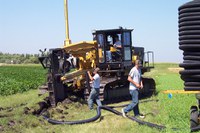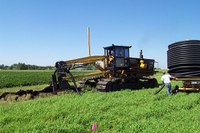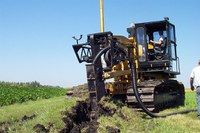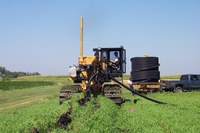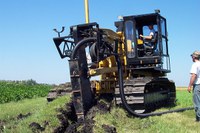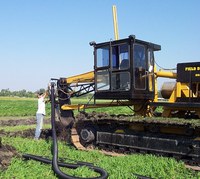NDSU Starts Tile Drainage Research Project
(Click an image below to view a high-resolution image that can be downloaded)
Although surface drainage is a component of a successful water management system, tile drainage (subsurface drainage) also is a very important practice in many parts of the Midwest and elsewhere.
“Tile drainage can help establish more optimum conditions for field operations and crop growth by lowering the water table in poorly draining soils,” says Hans Kandel, North Dakota State University Extension Service agronomist. “From 1993 through 2008, excess water has significantly impacted crop production in the region. Most of the prevented planting acres were a result of excess water. Along with acres not seeded due to water-logged conditions, excess water caused yield losses on acres that were harvested.”
A new NDSU tile drainage research site will investigate the yield response of the major crops grown in the Red River Valley under tiled and nontiled conditions. In addition to measuring yield, crop plants will be evaluated for disease and other growth characteristics.
Soil scientists will monitor the water table, water quality, soil properties and temperatures between tiled and nontiled experimental units.
“This research site has eight subunits, with each having a control structure to replicate tile-drained and nontile-drained conditions,” Kandel says. “Tile drainage is a very popular water management practice in the Corn Belt and southern Minnesota. However, there has been limited installation in North Dakota and northwest Minnesota until very recently. The adoption of this technology in the region is mainly due to an increase in rainfall since 1993 and prompted by higher land values, better crop prices and high input costs.”
North Dakota and northwest Minnesota farmers who have tile-drained their fields suggest that there are some real benefits to be gained from subsurface drainage. Farmers indicated that their tiled fields are where field operations take place first, instead of last. However, flat topography, tight soils, economic uncertainty and a tradition of surface drainage still limit its more widespread adoption in the region.
Both technical and economic feasibility must be understood clearly before tile drainage can become a widely accepted water management practice in the eastern part of North Dakota and northwestern Minnesota.
“This new NDSU research will investigate some of these unknown factors,” Kandel says. “A multidisciplinary team of scientists, including scientists from the University of Minnesota, are involved in the project. Plant pathologists will evaluate the effect of better drainage on plant diseases. Soil scientists will be involved to monitor the changes in the soil and agronomists will look at the growth, development and yield of different crops.”
Funding for the project comes from Field Drainage Inc., Hancor Tile Co., the Minnesota Wheat Research and Promotion Council, North Dakota State University Extension Service and North Dakota Agricultural Experiment Station. This will be a long-term project and the results will be shared with producers during winter NDSU Extension Service update sessions.
NDSU Agriculture Communication
| Source: | Hans Kandel, (701) 231-8135, hans.kandel@ndsu.edu |
|---|---|
| Editor: | Rich Mattern, (701) 231-6136, richard.mattern@ndsu.edu |

